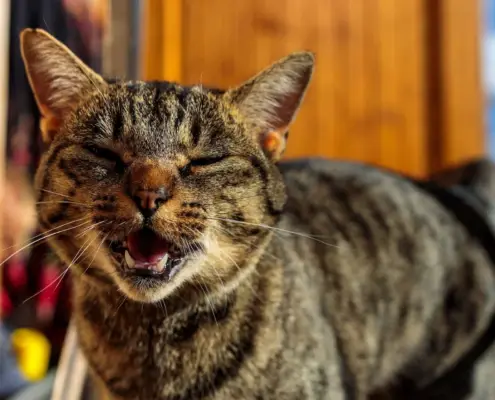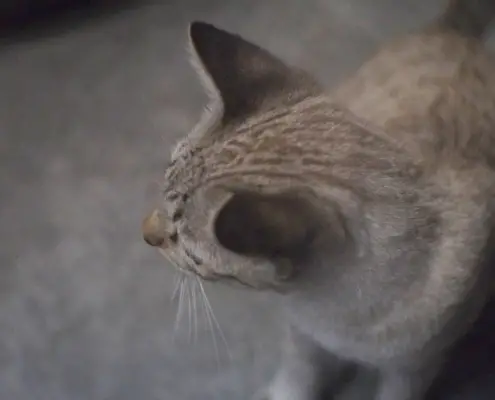
Cats have been captivating humans for centuries with their enigmatic and graceful presence. These fascinating creatures possess a multitude of unique traits and behaviors that set them apart from other animals. From their physical characteristics to their independent nature, cats continue to intrigue and charm their human companions. In this article, we will delve into the world of cats and explore what makes them so special.
Physical characteristics that set cats apart
One of the most distinctive physical features of cats is their retractable claws. Unlike dogs or other animals, cats have the ability to extend and retract their claws, allowing them to move silently and pounce with precision. Their sharp claws are not only essential for hunting but also serve as a means of self-defense.
Another physical characteristic that sets cats apart is their extraordinary flexibility. Cats have a highly flexible spine that enables them to twist, turn, and contort their bodies in ways that seem almost supernatural. This flexibility not only aids them in hunting but also allows them to fit into tight spaces and climb with ease.
Furthermore, cats possess exceptional night vision due to a structure in their eyes called the tapetum lucidum. This reflective layer enhances their ability to see in low light conditions, making them superb nocturnal predators. Cats are truly built for the hunt, and their physical attributes play a vital role in their survival.
Unique behaviors and instincts of cats
Cats exhibit a wide range of behaviors and instincts that make them truly unique. One of the most well-known behaviors is their grooming ritual. Cats are meticulous groomers, spending hours each day cleaning their fur with their rough tongues. This behavior not only helps them maintain a clean and healthy coat but also serves as a way to mark their territory with their scent.
Another fascinating behavior is their kneading instinct. Cats often display this behavior by rhythmically pushing their paws against a soft object, such as a blanket or their human’s lap. Kneading is believed to be a leftover instinct from kittenhood when they would knead their mother’s belly to stimulate milk production. It is a sign of contentment and relaxation for adult cats.
Cats also possess a strong prey drive, which is deeply rooted in their instincts. Their hunting instincts are triggered by the slightest movement or sound, and they will instinctively stalk, pounce, and capture their prey. This natural instinct is often seen in domestic cats when they chase after toys or playfully ambush their human companions.
The mysterious and independent nature of cats
One of the most intriguing aspects of cats is their mysterious and independent nature. Unlike dogs, who are often described as social animals, cats are more solitary creatures. They value their personal space and independence, yet they can form deep bonds with their human companions. Cats prefer to have a sense of control over their environment and will often choose when and how they interact with others.
Cats are also known for their aloof behavior, which can be misinterpreted as indifference. However, this is not the case. Cats have a complex range of emotions and can form strong attachments to their human caregivers. Their aloofness is often a defense mechanism to assess new situations and ensure their safety. Once a cat feels secure, they can be affectionate and loving companions.
Furthermore, cats are highly skilled at hiding any signs of pain or discomfort. This behavior stems from their instinctual need to appear strong and avoid showing vulnerability. It is crucial for cat owners to understand this behavior and be vigilant in monitoring their cat’s health and well-being.
Communication methods and body language of cats
Cats communicate in a variety of ways, both through vocalizations and body language. Meowing is perhaps the most well-known vocalization of cats, but it is primarily used to communicate with humans. Cats rarely meow to communicate with each other. Instead, they rely on a wide range of vocalizations, such as purring, hissing, growling, and chirping, to convey their emotions and intentions.
Body language plays a significant role in cat communication. For example, an upright and relaxed tail indicates a content and confident cat, while a puffed-up tail indicates fear or aggression. Similarly, flattened ears indicate fear or submission, while ears pointed forward show curiosity or attentiveness. Understanding these subtle cues is essential in deciphering a cat’s mood and ensuring effective communication.
Additionally, cats use scent marking as a means of communication. They have scent glands located on their cheeks, chin, and paws, which they use to mark objects and territory. By leaving their scent behind, cats are effectively communicating with other cats, signaling their presence and ownership of a particular space.
Cats’ hunting skills and their impact on their behavior
Cats are natural-born hunters, and their hunting skills have a profound impact on their behavior. Even domestic cats, who are well-fed and do not rely on hunting for survival, retain their innate hunting instincts. This instinctual drive can lead to behaviors such as stalking, pouncing, and play hunting.
Engaging in hunting behaviors provides cats with mental and physical stimulation. It allows them to exercise their natural instincts and helps prevent boredom and obesity. Providing interactive toys and engaging in play sessions that mimic hunting can greatly enrich a cat’s environment and promote their overall well-being.
However, it is important to note that hunting behaviors can sometimes be problematic, especially when directed towards wildlife or other pets. It is essential for cat owners to provide appropriate outlets for their cat’s hunting instincts and to implement measures to prevent them from causing harm to other animals.
Cats’ sensitivity to their environment and their territorial nature
Cats are highly sensitive to their environment and can be easily affected by changes in their surroundings. They are creatures of habit and thrive in a stable and predictable environment. Even minor changes, such as rearranging furniture or introducing a new pet, can cause stress and anxiety in cats.
Cats are also territorial animals and have a strong need to establish and defend their territory. They mark their territory with scent and visual cues, such as scratching furniture or rubbing against objects. This behavior helps them feel secure and assert their ownership of a particular space.
Understanding a cat’s sensitivity to their environment and their territorial nature is crucial in providing them with a safe and stress-free environment. Creating designated areas for scratching, providing hiding spots, and maintaining a consistent routine can help alleviate stress and promote a harmonious living environment for both cats and their human companions.
The unique bond between cats and humans
Despite their independent nature, cats are capable of forming deep and meaningful bonds with their human caregivers. The bond between cats and humans is built on trust, respect, and mutual affection. Cats have the ability to sense their human’s emotions and provide comfort and companionship during difficult times.
Cats are known for their intuitive nature and have been known to detect illnesses or changes in their human’s health. They can offer emotional support and provide a calming presence, especially for individuals dealing with anxiety or depression. The unique bond between cats and humans is truly special and brings immense joy and companionship to both parties.
Common misconceptions about cats’ behaviors
There are several common misconceptions about cats’ behaviors that can lead to misunderstandings and miscommunication. One prevalent misconception is that cats are aloof and unaffectionate. As discussed earlier, cats have complex emotions and can form deep bonds with their human companions. Their aloof behavior is often a defense mechanism and should not be mistaken for a lack of affection.
Another misconception is that cats are purely independent and do not require social interaction. While it is true that cats value their independence, they still need social stimulation and interaction with their human caregivers. Quality playtime, grooming sessions, and gentle affectionate gestures are essential in nurturing the bond between cats and humans.
Additionally, cats are often misunderstood when it comes to their hunting behaviors. It is important to remember that hunting is an innate instinct for cats and should not be seen as aggressive or malicious behavior. Providing appropriate outlets for hunting, such as interactive toys, can help redirect their hunting instincts in a positive way.
Celebrating the uniqueness of cats
In conclusion, cats possess a multitude of unique traits and behaviors that set them apart from other animals. From their physical characteristics to their independent nature, cats continue to fascinate and captivate their human companions. Understanding and appreciating the uniqueness of cats allows us to forge a deeper connection with these extraordinary creatures. So, let us celebrate the enigmatic world of cats and embrace the joy and wonder they bring to our lives.
If you enjoyed my article, I would appreciate you sharing it with your network.

Sima Ndlebe
Sima writes for CatBuzz. He is interested in Cats, Health and Fitness, and Entrepreneurship.
Published: 30 October 2023



